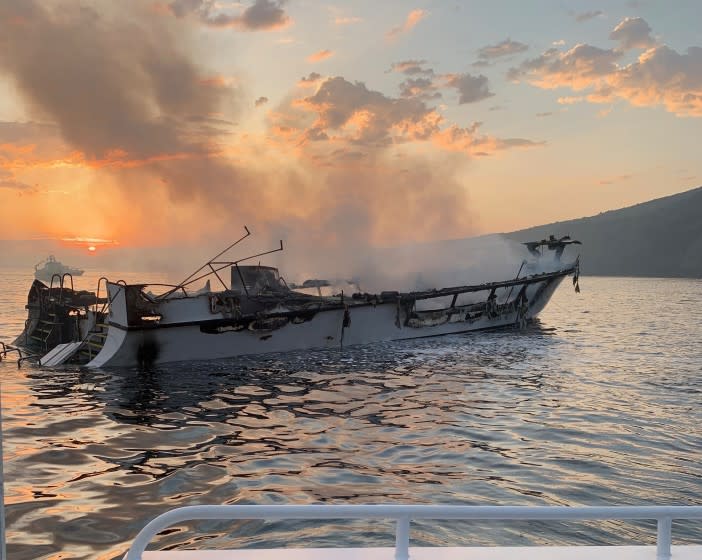Conception boat fire victims were awake, might have been saved with warning, NTSB says

More than a year after the worst maritime disaster in modern California history, federal regulators this week offered grim new findings about the last moments of those who died aboard the Conception dive boat when it caught fire off the Santa Barbara coast.
National Transportation Safety Board Chairman Robert Sumwalt said Tuesday that the 33 passengers and one crew member who perished below deck likely could have escaped if there had been earlier detection of the blaze on Labor Day 2019.
The board found that the fire was burning for at least 30 minutes before a crew member sleeping in the wheelhouse atop the three-deck boat was awakened by the pop, crackle and glow of the flames from the middle deck.
The NTSB determined that most of those below deck were awake — some with their shoes on — as the fire engulfed the vessel about 3 a.m., but they could not escape the bunk room and died of smoke inhalation.
The probable cause
The NTSB report offers the clearest evidence yet of what happened. Here are the key findings:
— Although the NTSB determined that the fire began in the back of a middle-deck salon, where lithium-ion batteries of divers' personal devices were being charged, the agency could not say whether it was the batteries, the ship’s electrical system or another unattended fire source that ignited the blaze.
— Truth Aquatics, the Conception's owner, failed to have effective oversight of the vessel, and those shortcomings included having no roving watch commander on duty, a Coast Guard requirement for whenever passengers are below deck, who likely would have detected the fire sooner and could have saved lives.
— The NTSB also found that the Conception did not have smoke detectors installed in the area where the fire started. While placing much of the blame on Truth Aquatics, the agency also faulted government regulators and a lack of Coast Guard requirements for smoke detectors.
— The high loss of life was due, in part, to the fact that all the below-deck escape routes led to the same location — the salon and the galley in the middle deck where the fire ignited.
The recommendations
— The NTSB called for vessels like or larger than the Conception — new or old — with overnight accommodations to be required to have interconnected smoke detectors in all passenger areas.
— It recommended that a secondary means of escape leading into a different space than the primary exit be required on all small passenger vessels with overnight accommodations.
— The board also called on the Coast Guard to develop and implement an inspection program to verify that required roving watches are posted for the safety of sleeping passengers and crew.
— The NTSB reiterated that it had previously called for small passenger vessels to be required to implement safety management systems. It noted that the Coast Guard had not heeded prior safety recommendations going back years.
“The Conception may have passed all Coast Guard inspections, but that did not make it safe,” Sumwalt said. “Our new recommendations will make these vessels safer, but there is no rule change that can replace human vigilance.”
The NTSB's proposals will now be considered by the Coast Guard, which previously had exempted more than 100 California boats — including the Conception — from adopting strict passenger safety rules, according to a Times data analysis.
The Coast Guard responded to the recommendations with a statement:
"We will look at all possible factors that may have caused this incident, including those associated with regulations or oversight, and make recommendations for any necessary changes. The Coast Guard will carefully consider the National Transportation Safety Board’s recommendations through a deliberate process, which will include a review by all subject matter experts and senior leaders responsible for implementing the potential regulatory changes."
This story originally appeared in Los Angeles Times.

